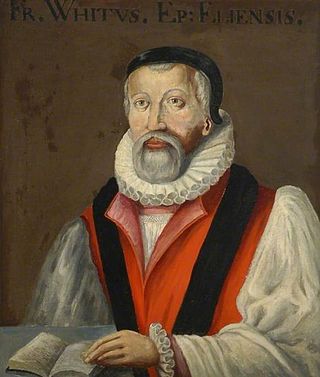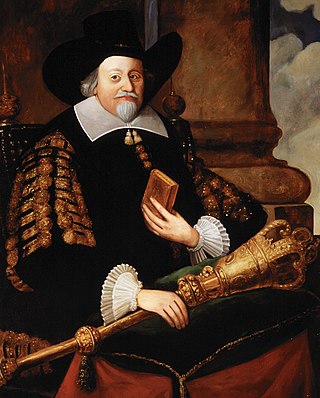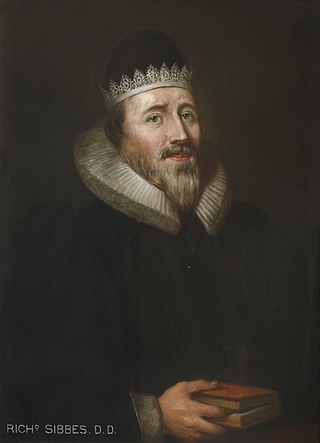
The Elizabethan Religious Settlement is the name given to the religious and political arrangements made for England during the reign of Elizabeth I (1558–1603). The settlement, implemented from 1559 to 1563, marked the end of the English Reformation. It permanently shaped the Church of England's doctrine and liturgy, laying the foundation for the unique identity of Anglicanism.

John Davenport was an English Puritan clergyman and co-founder of the American colony of New Haven.

Timothy Cutler was an American Episcopal clergyman and rector of Yale College.

Francis White was an English bishop and controversialist.

Peter Heylyn or Heylin was an English ecclesiastic and author of many polemical, historical, political and theological tracts. He incorporated his political concepts into his geographical books Microcosmus in 1621 and Cosmographie (1657).

Francis Rous, also spelled Rouse, was an English politician and Puritan religious author, who was Provost of Eton from 1644 to 1659, and briefly Speaker of the House of Commons in 1653.

Richard Sibbes (1577–1635) was an Anglican theologian. He is known as a Biblical exegete, and as a representative, with William Perkins and John Preston, of what has been called "main-line" Puritanism because he always remained in the Church of England and worshiped according to the Book of Common Prayer.
In 17th century England, Thorough was a name given by Thomas Wentworth, 1st Earl of Strafford to a scheme of his to establish absolute monarchy in England. Although "Thorough" is largely attributed to Strafford, its implementation can also be accredited to the Archbishop of Canterbury William Laud.

Impropriation, a term from English ecclesiastical law, was the destination of income from tithes of a church benefice to a layman. With the establishment of the parish system in England, it was necessary for all church property and income to have a specific owner. This was the parochianus, parson, or rector who was sustained by the benefice income while providing personally for the cure of souls, the everyday pastoral and religious duties. The parson was technically a corporation sole. Over the centuries, the benefice came to be considered a piece of property whose holder could discharge the spiritual responsibilities by a deputy, and many parishes were annexed by monasteries or other spiritual corporations, a process known as appropriation. These ecclesiastical holders were bound to provide for a cleric known as a 'vicar' for the cure of souls, but could use any excess income as they pleased.

John Robinson (1576–1625) was the pastor of the "Pilgrim Fathers" before they left on the Mayflower. He became one of the early leaders of the English Separatists called Brownists, and is regarded as one of the founders of the Congregational Church.

James VI and I, King of Scots, King of England, and King of Ireland, faced many complicated religious challenges during his reigns in Scotland and England.

The Caroline Divines were influential theologians and writers in the Church of England who lived during the reigns of King Charles I and, after the Stuart Restoration, King Charles II. There is no official list of Caroline-era divines; they are defined by the era in which they lived, and Caroline Divines hailed from England, Ireland, Scotland, and Wales. However, of these four nations, it is Caroline England which is most commonly considered to have fostered a golden age of Anglican scholarship and devotional writing, despite the socio-cultural upset of civil war, regicide, and military rule under Oliver Cromwell. Importantly, the term divine is restricted neither to canonised saints nor to Anglican figures, but is used of many writers and thinkers in the wider Christian church.

John Preston (1587–1628) was an Anglican minister and master of Emmanuel College, Cambridge.

Laudianism was an early seventeenth-century reform movement within the Church of England, promulgated by Archbishop William Laud and his supporters. It rejected the predestination upheld by the previously dominant Calvinism in favour of free will, and hence the possibility of salvation for all men. Laudianism had a significant impact on the Anglican high church movement and its emphasis on liturgical ceremony and clerical hierarchy. Laudianism was the culmination of the move towards Arminianism in the Church of England, but was neither purely theological in nature, nor restricted to the English church.

The reign of King James I of England (1603–1625) saw the continued rise of the Puritan movement in England, that began during reign of Queen Elizabeth (1558–1603), and the continued clash with the authorities of the Church of England. This eventually led to the further alienation of Anglicans and Puritans from one another in the 17th century during the reign of King Charles I (1625–1649), that eventually brought about the English Civil War (1642–1651), the brief rule of the Puritan Lord Protector of England Oliver Cromwell (1653–1658), the English Commonwealth (1649–1660), and as a result the political, religious, and civil liberty that is celebrated today in all English speaking countries.

Under Charles I, the Puritans became a political force as well as a religious tendency in the country. Opponents of the royal prerogative became allies of Puritan reformers, who saw the Church of England moving in a direction opposite to what they wanted, and objected to increased Catholic influence both at Court and within the Church.

Arminianism was a controversial theological position within the Church of England particularly evident in the second quarter of the 17th century. A key element was the rejection of predestination. The Puritans fought against Arminianism, and King James I of England opposed it before, during, and after the Synod of Dort, 1618–1619, where the English delegates participated in formulating the Calvinist Canons of Dort, but his son Charles I, favoured it, leading to deep political battles. The Methodists, who espoused a variant of the school of thought called Wesleyan–Arminian theology, branched off the Church of England in the 18th century.

Historians have produced and worked with a number of definitions of Puritanism, in an unresolved debate on the nature of the Puritan movement of the 16th and 17th century. There are some historians who are prepared to reject the term for historical use. John Spurr argues that changes in the terms of membership of the Church of England, in 1604–6, 1626, 1662, and also 1689, led to re-definitions of the word "Puritan". Basil Hall, citing Richard Baxter. considers that "Puritan" dropped out of contemporary usage in 1642, with the outbreak of the First English Civil War, being replaced by more accurate religious terminology. Current literature on Puritanism supports two general points: Puritans were identifiable in terms of their general culture, by contemporaries, which changed over time; and they were not identified by theological views alone.
Henry Archer, also known as John Archer, was a Fifth Monarchist. His book The Personall Reigne of Christ Upon Earth (1642) was popular in the 1650s.

William Laud was a bishop in the Church of England. Appointed Archbishop of Canterbury by Charles I in 1633, Laud was a key advocate of Charles I's religious reforms; he was arrested by Parliament in 1640 and executed towards the end of the First English Civil War in January 1645.














